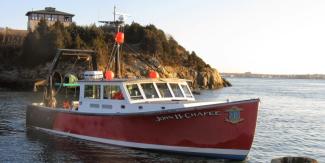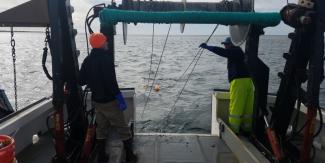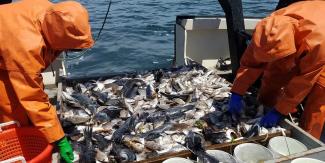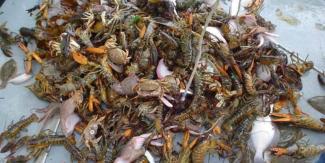Coastal Trawl Survey
Background
The Rhode Island Coastal Trawl Survey includes a seasonal survey that has been conducted since 1979 along with the complimentary Narragansett Bay monthly survey since 1990. The purpose of the seasonal and monthly trawl survey is to provide fisheries independent data for a comprehensive resource assessment of finfish and crustaceans in Rhode Island State waters.
Survey Design
The monthly survey samples 13 fixed stations distributed throughout Narragansett Bay. These stations were chosen to represent the various depth stratum and habitats while also investigating the temporal distribution of species found throughout the bay.
The seasonal survey includes 12 monthly stations as well as an additional 14 randomly chosen stations in the bay and 18 fixed stations in Rhode Island Sound and Block Island Sound.
Survey Gear
The finfish and crustaceans are collected using a 2-seam otter trawl with a 210 x 4.5” mesh fishing circle. The trawl has a 40’ headrope and 55’ footrope. The trawl uses a chain sweep consisting of 5/16 “ chain hung at 12 inch spacing with 13 links per space. There is a double sweep that consists of 16 loops of 3/8” chain shackled to the center of the main sweep. There are seven 8-inch floats spaced evenly along the headrope. The codend of the trawl is fitted with a ¼ “mesh liner to help retain juvenile and adult finfish and crustaceans. The bridles on the trawl are constructed of 48’ 3/8” wire attached to 44” Type 4 Thyboron trawl doors. The trawl doors are fitted with Notus doors sensors to monitor how the gear is fishing in real-time.
The trawl is currently towed off the western-rigged RV John H. Chafee. The RV John H. Chafee was built in 2002 using a 50’ Wesmac hull and powered by a 700 hp 3406 Caterpillar engine. The research vessel was designed to conduct the trawl survey as well as other projects both internal and with collaborators.
Sampling Methods
Upon arriving at the selected station hydrographic and environmental data are recorded before setting the trawl net. The net is deployed and towed for 20 minutes, once the winches are stopped, at 2.5 knots and 5:1 scope of tow wire which equates to .83 nm of sea bottom swept. During the tow the net is monitored using the Notus system and visual ques to ensure the net is fishing properly. During haul back of the trawl all species in the net are retained and dumped in a checker area on the aft deck. The catch is sorted by species and held in buckets and tanks of seawater to reduce mortality.
Once the catch is sorted, total weights are collected for all species. In the event of a large catches, a random sub-sample is chosen to represent the species composition to be used for measurements. All species are measured and recorded to the nearest centimeter or millimeter depending on defined protocol. Once weighed and measured the catch is returned to the sea immediately to reduce mortality. Any species needed for age and growth are cataloged and stored for further analysis at the lab.
Sampling Frequency
The Rhode Island Coastal Trawl survey is conducted year-round. The monthly portion of the survey is conducted 12 months a year during the middle of each month. The seasonal portion of the survey is conducted during the Spring and Fall. The spring portion of the survey begins in April and concludes in May. The Fall portion of the survey begins in September and concludes in October.
The Rhode Island Coastal Trawl survey has been in operation for over 38 years conducting 6,595 survey tows and collected data on 132 species.
For more information about the survey please contact Scott Olszewski or Chris Parkins




